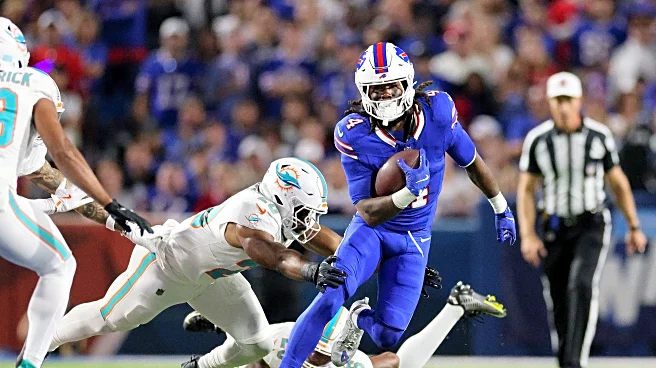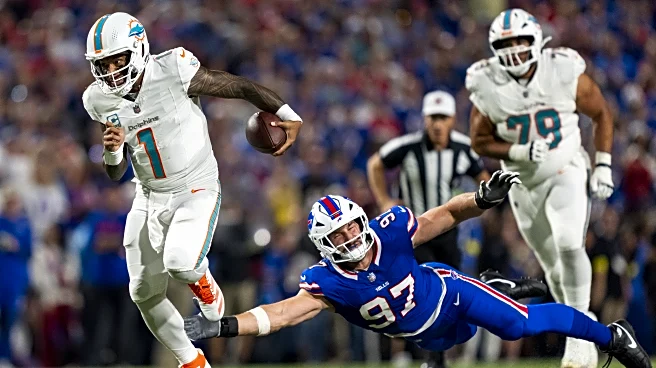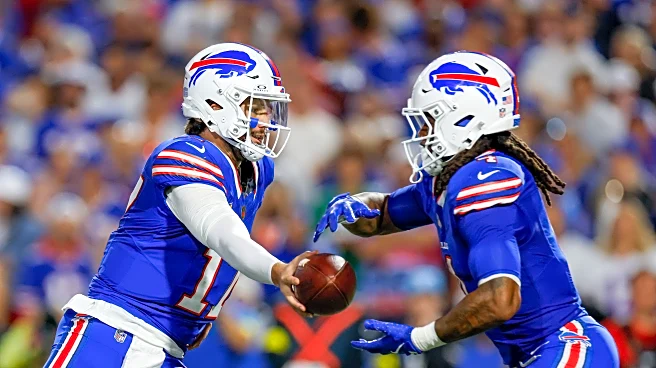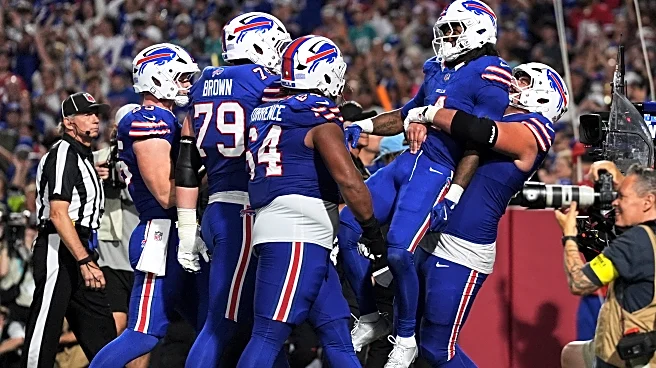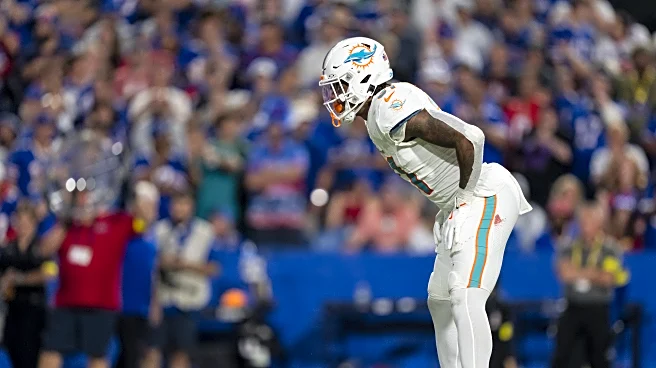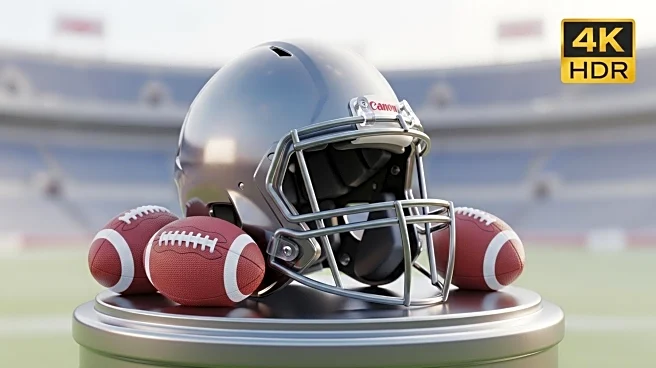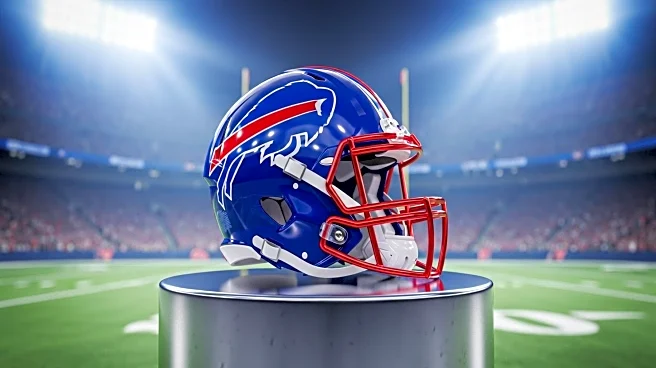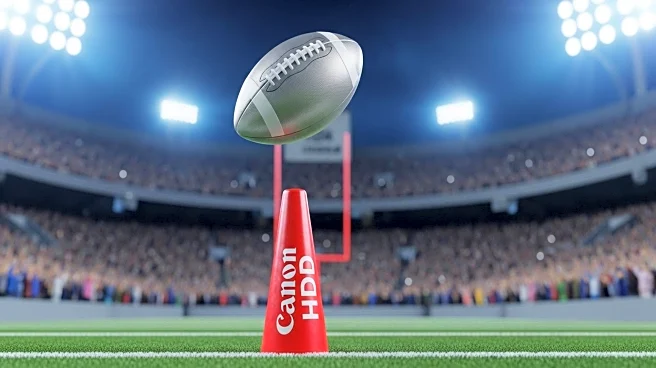The Buffalo Bills’ path to victory against the winless Miami Dolphins wasn’t as easy as most people expected. What started as a potential rout fueled by Josh Allen’s early magic and a balanced attack, turned into a gritty, back-and-forth affair tied at 21 entering the fourth quarter. Miami’s shorthanded defense put up a great fight, forcing three punts in the second half, and their offense converted all three red-zone trips into touchdowns. However, a roughing-the-punter penalty on Zach Sieler extended
a Bills drive, leading to Khalil Shakir’s go-ahead score. Then, as we all know now, came Terrel Bernard’s game-sealing interception of Tua Tagovailoa, which snuffed out Miami’s final threat.
With injuries mounting on both sides — Buffalo without defensive tackle Ed Oliver and linebacker Matt Milano, Miami missing key secondary pieces — it was a matchup where vulnerabilities proved exploitable. Josh Allen wrote his name again in the record books, becoming the fastest player to 300 career touchdowns (including playoffs), but the defense’s third-down woes were back, allowing Miami to convert 10 of 15 attempts.
As the Bills prepare for the New Orleans Saints as the second matchup in a three-game homestand, let’s break down the players trending up and down after Week 3.
Trending Up: Building momentum in Orchard Park
These three players stood out the most in a game that tested Buffalo’s depth, each delivering game-changing plays and furthering their cases as foundational pieces.
1. Dalton Kincaid, TE

Kincaid showed why Bills’ fans have expected more from him since his rookie season. On Thursday, he was Buffalo’s go-to pass catcher, hauling in five receptions for 66 yards and a touchdown on eight targets against Miami. That was his third straight game with four-plus catches, which is a franchise first for a tight end.
Kincaid’s 20-yard score in the first quarter set the tone, exploiting a seam route against Miami’s depleted secondary, and he added a crucial third-down grab in the fourth to keep the game-winning drive alive. Through three weeks, Kincaid leads the Bills with 13 receptions for 151 yards and two TDs, outpacing Khalil Shakir in target share (20.3% vs. 18.1%).
Advanced metrics back the surge: Kincaid’s 84.2 Pro Football Focus (PFF) receiving grade ranks top-five among TEs, with a league-high 2.1 yards per route run (YPRR) in Weeks 1-3. Kincaid also had a +1.8 EPA on his TD grab, per Next Gen Stats. His 78% catch rate on contested balls (up from 62% in 2024) speaks to his being a player with great hands who also has Allen’s trust, as evidenced by a 15.2% air-yard share — the highest of his career.
In an offense craving reliability, Kincaid’s pass-catching ability (averaging 11.6 yards per catch) makes him incredibly valuable, especially with Dawson Knox rotating at just 45% snaps and struggling with some drops. The Bills need Kincaid to keep it up all season long to become a true mismatch inside, making life easier for wide receivers outside.
2. Tyrell Shavers, WR

Shavers is the breakout story of training camp turned reality, evolving from a practice-squad project into a special teams/blocker, and now into a legitimate pass-catching threat. He hauled in three receptions for 42 yards on four targets against the Dolphins, including a 17-yard first-down grab that sparked Buffalo’s second-half comeback.
Starting the season buried on the depth chart behind prized free-agent signing Joshua Palmer (a three-year, $36 million deal), Shavers logged just 12% of offensive snaps in Week 1. He exploded to 28% against Miami, outpacing Palmer’s 22% share. His contributions in the run game as a blocker, on special teams as a gunner, and now as a reliable pass-catching weapon mirrors the role Mack Hollins filled in 2024, but with added YAC burst (8.2 yards after catch per reception).
PFF grades Shavers at 79.6 in receiving (top-15 among WRs with <20 targets), with a 4.1% drop rate and +0.9 EPA on his deep out — key in a game where Buffalo averaged 6.2 air yards per attempt. As the Hollins successor, Shavers’ blocking (82% win rate) and special teams reps (15 tackles in preseason) secured his roster spot, but his 2.3 YPRR (yards per route run) ranks seventh among Bills skill players. With Palmer struggling (1-12, 1.2 YPRR), Shavers might find himself earning more playing time on offense, just like Hollins was able to steal reps from Amari Cooper last season.
3. Terrel Bernard, LB

With Milano sidelined, Bernard stepped up as the defensive anchor, notching the game’s only turnover — an interception of Tagovailoa at Buffalo’s 21-yard line with 3:05 left, which sealed the win. “Mr. 4th quarter” added seven tackles (six solo), a TD-saving stop on Miami’s opening drive, and a stuff of running back De’Von Achane for no gain.
Bernard’s 82.4 PFF coverage grade was Buffalo’s highest among defenders, allowing just a 50% completion rate on targets (down from 65% in Weeks 1-2). His +1.8 EPA on the pick was clutch, stopping a Dolphins offense that was getting in position to make it a tough game at the end.
Dating to last season, Bernard’s 17.0% missed tackle rate improved to 8.3% in Week 3, per PFF, and his film-study prep (he diagnosed the route with the RB movement pre-snap) and clutch gene always shows, like in his Week 1 fumble recovery off Derrick Henry. In a front seven missing speed (Oliver out), Bernard’s instincts are massively important.
Trending Down: Cause for concern amid a great start
Even in victory, these players could’ve been better, highlighting areas where Buffalo can improve as they continue down the path to the playoffs.
1. T.J. Sanders, DT

Sanders was expected to have a huge impact in the interior, especially helping the pass rush and the struggling third-down defense. So far, it hasn’t happened. Sanders underwhelmed in Ed Oliver’s absence, logging 28 defensive snaps (42% share) but registering zero tackles, pressures, or stops on Miami’s 10-of-15 third-down conversions . The Bills ranked 28th in third-down stop rate entering Week 3. A high-upside athlete (4.95 40-yard dash at 305 pounds), Sanders was repeatedly washed out of gaps and failed to disrupt Tagovailoa’s pocket on key 3rd & Longs.
Sanders’ 52.1 PFF run-defense grade ranks bottom-10 among DTs, with a -1.2 EPA surrendered on run plays — worse than his 58.3 overall grade in Weeks 1-2. Outplayed by fourth-round rookie Deone Walker (who started beside DaQuan Jones and notched a game-clinching tip on the Bernard INT), Sanders’ 12% pass-rush win rate lags Walker’s 18%, per PFF.
With Oliver’s return looming, Sanders’ lack of impact raises questions about his short-term impact. It’s early, but with Walker looking like the superior player, this second-round pick looks like another questionable selection by Brandon Beane.
2. Javon Solomon, DE

Solomon has earned some extra reps (35% snap share, up from 22% in Week 2), contributing to Buffalo’s improved run defense (Miami averaged 3.9 YPC, down from 5.2 league-wide). But as a pass-rushing edge, he failed to register a single pressure or QB hit on 18 pass-rush snaps. That allowed Tagovailoa a clean pocket on 72% of dropbacks — exacerbating the Bills’ 2.1-second time-to-throw average.
Solomon’s 48.7 PFF pass-rush grade ranks 42nd among EDGEs, with zero sacks through three weeks and a -0.8 EPA on blitzes (bottom-15 qualifier). His quick-twitch traits (Troy college leader with 15 sacks in 2023) shone in run stuffs (two TFLs), but a 6.2% win rate trails Greg Rousseau’s 12.4%. Head coach Sean McDermott noted postgame that third-round rookie edge rusher Landon Jackson “was close” to activation last week, hinting at rotation pressure as Hoecht nears return in Week 7.
For Solomon, the clock is ticking. The Bills need his bend to translate, or he’ll be at risk of sliding behind Jackson’s raw traits (6.5 college sacks in 2024), and even losing his roster spot when Hoecht is finally back.
3. Tre’Davious White, CB

White’s limitations in coverage were glaring against Miami’s speed, allowing wide receiver Jaylen Waddle’s 25-yard TD scamper just before halftime and a 15-yard fourth-down conversion that kept Miami alive. He was targeted six times, yielding four catches for 62 yards (10.3 YAC per reception), clearly afraid of getting beat over the top and allowing easy completions in front of him.
The veteran’s 58.2 PFF coverage grade ranks 45th among CBs, with a 72% completion rate allowed (up from 62% in 2024). His -1.2 EPA on targets was Buffalo’s worst in the secondary, per Next Gen Stats, as Miami exploited zone shells (Buffalo’s base defense). Post-ACL rehab, White’s burst might be back, as we can see when he attacks what’s in front of him, especially against the run. However, he certainly won’t ever be as good as he was in coverage pre-injury — coaches must scheme more help going his side to hide him in those situations.
Honorable Mentions
Trending Up:
Josh Allen (22/28, 213 yds, 3 TDs; 300th career TD, 0.28 EPA/dropback — consistent MVP pace since 2024)
James Cook (19 car, 108 yds, TD; 5.7 YPC, +2.1 EPA — workhorse emerging)
Jackson Hawes (1 rec, TD — first career score, flashing in three-TE sets)
Ty Johnson (3 rec, 28 yds — surpassing Ray Davis for backup snaps)
Trending Down:
Matt Prater (39-yd FG miss; 82% FG rate, -0.5 EPA — one awful kick among a stellar Bills career so far)
Christian Benford (5 tackles, PI flag; 55.7 PFF grade, 18.2% explosive passes allowed — CB1 struggles)
Dawson Knox (2 rec, 12 yds; 3.2% target share).
At 3-0, the Bills are the clear division favorites (+31 point differential leads the AFC East), but third-down defense (28th in stop rate) and pass-rush depth loom large. Allen’s wizardry buys time, but McDermott’s crew must find solutions for the playoffs. Next up: New Orleans Saints on September 28. Go Bills!
Catch up on all this and more with the latest edition of Leading the Charge!

